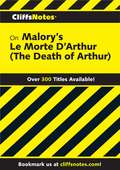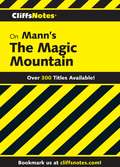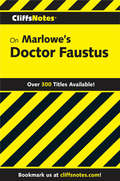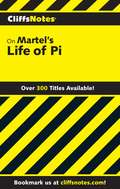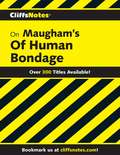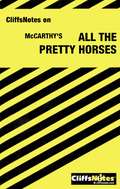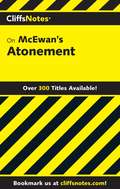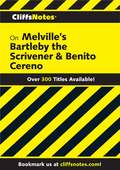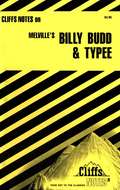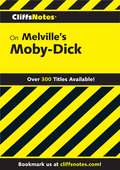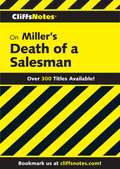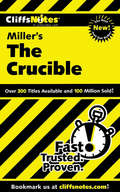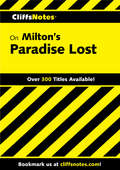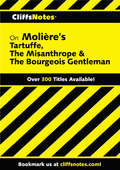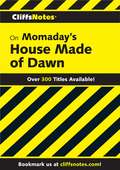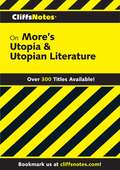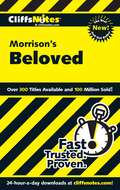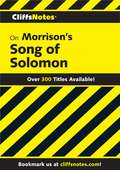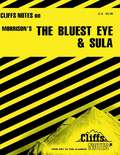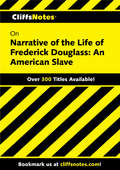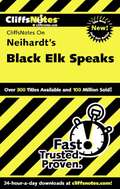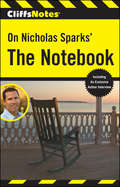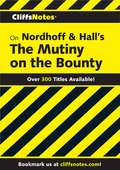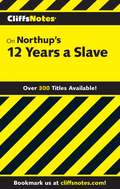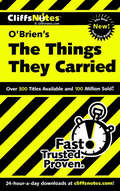- Table View
- List View
CliffsNotes on Malory's Le Morte d’Arthur
by John GardnerWritten in the 15th century, this version of the legend of King Arthur is perhaps the most famous. Filled with stories of adventure and chivalry among the knights of the Round Table in Camelot, love, and magic, it sets the imagination in motion.
CliffsNotes on Mann's The Magic Mountain
by Herberth CzermakThis CliffsNotes guide includes everything you’ve come to expect from the trusted experts at CliffsNotes, including analysis of the most widely read literary works.
CliffsNotes on Marlowe's Doctor Faustus
by Eva FitzwaterThis CliffsNotes guide includes everything you've come to expect from the trusted experts at CliffsNotes, including analysis of the most widely read literary works.
CliffsNotes on Martels Life of Pi
by Abigail WheetleyThis EBOOK Lit Note from the experts at CliffsNotes on Yann Martel's acclaimed Life of Pi includes plot summaries and commentaries, and character analyses on this best-selling book. Features of this Lit Note from the experts at CliffsNotes include: Focused summaries of the plot and analysis of important themes, symbols, and character developmentCharacter analyses of major characters, focusing on what makes each character "tick" and how each character grows throughout the novelBrief synopsis of the entire bookShort quiz
CliffsNotes on Maugham's Of Human Bondage
by Frank B. HugginsThis CliffsNotes guide includes everything you’ve come to expect from the trusted experts at CliffsNotes, including analysis of the most widely read literary works.
CliffsNotes on McCarthy's All the Pretty Horses
by Jeanne InnessThe original CliffsNotes study guides offer expert commentary on major themes, plots, characters, literary devices, and historical background. Run away with John and Lacey in CliffsNotes on All the Pretty Horses. McCarthy's adventure novel brings you along on a journey through Texas and into Mexico. Explore the loss of innocence, mankind's relationship to nature, and more. With help from this study guide, you won't be confused by the Spanish terminology or unnamed characters. Clear explanations and summaries will keep you on track with the plot from beginning to end. Other features that help you study includeA character map that graphically illustrates the relationships among the charactersInformation on the life and background of Cormac McCarthyCritical essaysIn-depth character analysesGlossary of unfamiliar termsReview questions and suggested writing topicsClassic literature or modern modern-day treasure--you'll understand it all with expert information and insight from CliffsNotes study guides.
CliffsNotes on McEwan's Atonement
by Curry KennedyCliffsNotes on Ian McEwan's Atonement includes summaries and analyses of this Booker Prize-nominated novel about how secrets emerge and change the entire course of everyone involved in an upper-middle-class English country home.
CliffsNotes on Melville's Bartleby, the Scrivener & Benito Cereno
by Mary Ellen SnodgrassThis CliffsNotes guide includes everything you've come to expect from the trusted experts at CliffsNotes, including analysis of the most widely read literary works.
CliffsNotes on Melville's Billy Budd & Typee, Revised Edition
by Mary Ellen SnodgrassExplore two lively classic tales of adventure on the high seas with CliffsNotes Billy Budd & Typee, the study guide that can raise your insight as well as your test scores! Meet Billy Budd, the sailor that everyone likes . . . or do they? And then set sail through the wild side of the South Seas in Typee. You'll be up to speed on all the plot details and more with in-depth character analysis, critical essays, and insight into the novel's literary devices. You'll also discover background information on the life of Herman Melville and his place in American literature.
CliffsNotes on Melville's Moby-Dick
by Stanley P BaldwinThe original CliffsNotes study guides offer expert commentary on major themes, plots, characters, literary devices, and historical background.In CliffsNotes on Moby-Dick, you follow along this great American novel; the turbulent and adventurous story of a sea captain's obsession with a white whale.This study guide shares a story about defiance, friendship, duty, and death — all immersed in symbolism, such as the white whale, itself. You'll gain comfort with the dark and complicated plot as you move through critical commentaries on each of the novel's 135 chapters. Other features that help you figure out this important work includeLife and background of the author, Herman MelvilleAnalyses of the charactersIntroduction to the novelA review section that tests your knowledge and suggests essay topicsA selected bibliography that leads you to more great resourcesClassic literature or modern-day treasure — you'll understand it all with expert information and insight from CliffsNotes study guides.
CliffsNotes on Miller's Death of a Salesman
by Jennifer L. ScheidtThe original CliffsNotes study guides offer a look into critical elements and ideas within classic works of literature. The latest generation of titles in this series also feature glossaries and visual elements that complement the classic, familiar format.CliffsNotes on Death of a Salesman shares an intimate glimpse into the dreams and disappointments of an American family.Following the story of Willy Loman, an aging salesman who can't accept change within himself and society, this study guide provides a character list, character map, and character analyses to explore the personalities within Arthur Miller's masterful play. Other features that help you figure out this important work includePersonal and career background of the authorIntroduction to and brief synopsis of the playSummaries and expert commentaries for each act and sceneEssays that explore the play's major themes and the author's manipulation of time and spaceA review section that tests your knowledge and suggests essay topics and practice projectsA Resource Center full of books, publications, films, and Internet resourcesClassic literature or modern-day treasure -- you'll understand it all with expert information and insight from CliffsNotes study guides.
CliffsNotes on Miller's The Crucible
by Jennifer L. Scheidt Denis M. CalandraThe original CliffsNotes study guides offer a look into critical elements and ideas within classic works of literature. The latest generation of titles in this series also feature glossaries and visual elements that complement the classic, familiar format.CliffsNotes on The Crucible takes you into Arthur Miller's play about good and evil, self-identity and morality.Following the atmosphere and action of the Salem witch trials of the 1600s, this study guide looks into Puritan culture with critical commentaries about each act and scene. Other features that help you figure out this important work includeLife and background of the authorIntroduction to the playCharacter web and in-depth analyses of the major rolesSummaries and glossaries related to each actEssays that explore the author's narrative technique and the play's historical settingA review section that tests your knowledge and suggests essay topics and practice projectsA Resource Center for checking out details on books, publications, and Internet resourcesClassic literature or modern-day treasure -- you'll understand it all with expert information and insight from CliffsNotes study guides.
CliffsNotes on Milton's Paradise Lost (Cliffsnotes Ser.)
by Bob LinnThe original CliffsNotes study guides offer a look into critical elements and ideas within classic works of literature. The latest generation of titles in this series also features glossaries and visual elements that complement the classic, familiar format.CliffsNotes on Paradise Lost retells the Judeo-Christian story of creation, in which Milton provides an otherworldly look into the dialogue of God, Satan, and human beings. His subject is Adam's first disobedience to God and the loss of Eden. This dense classic has permeated and influenced philosophy for centuries.CliffsNotes concise supplement to Paradise Lost helps students understand the overall epic by providing plot synopses and analysis of each book. Other features that help you figure out this important work includeA look into the life of the author, John MiltonGlossaries to help you understand Milton's languageA character map to define the relationships between the charactersCritical essays about the major themes in the epic and Milton's styleA review section with a quiz, practice projects, and essay questions.Classic literature or modern-day treasure—you'll understand it all with expert information and insight from CliffsNotes study guides.
CliffsNotes on Moliere's Tartuffe, The Misanthrope & The Bourgeois Gentleman
by James L. Roberts Denis M. CalandraThis CliffsNotes guide includes everything you've come to expect from the trusted experts at CliffsNotes, including analysis of the most widely read literary works.
CliffsNotes on Momaday's House Made of Dawn
by H JaskoskiThis CliffsNotes guide includes everything you’ve come to expect from the trusted experts at CliffsNotes, including analysis of the most widely read literary works.
CliffsNotes on More's Utopia & Utopian Literature (Cliffsnotes Ser.)
by Harold M PriestThis CliffsNotes guide includes everything you’ve come to expect from the trusted experts at CliffsNotes, including analysis of the most widely read literary works.
CliffsNotes on Morrison's Beloved
by Mary Robinson<P> The original CliffsNotes study guides offer expert commentary on major themes, plots, characters, literary devices, and historical background. The latest generation of titles in this series also features glossaries and visual elements that complement the classic, familiar format. <P> CliffsNotes on Beloved sheds light on Toni Morrison's skill in penetrating the unconstrained, unapologetic inner motivations of numerous characters who shouldered the horrific burden of slavery's hidden sins. Less a suspense novel than a treatise on acceptance and endurance, this novel has struck an appreciative chord with those who value the painful process of creating a guilt-ridden, near-crazed survivor. <P>With help from this study guide, you'll not only survive - you'll thrive in your understanding of Morrison's memorable work. You'll also find valuable information about the author and her influences. Other features that help you study include <br> Character analyses of major players <br> A character map that graphically illustrates the relationships among the characters <br> Critical essays <br> A review section that tests your knowledge <br> A ResourceCenter full of books, articles, films, and Internet sites <br> Classic literature or modern modern-day treasure -- you'll understand it all with expert information and insight from CliffsNotes study guides.
CliffsNotes on Morrison's Song of Solomon
by Durthy A. WashingtonThis CliffsNotes guide includes everything you’ve come to expect from the trusted experts at CliffsNotes, including analysis of the most widely read literary works.
CliffsNotes on Morrison's The Bluest Eye & Sula
by Rosetta James Louisa S NyeThe original CliffsNotes study guides offer expert commentary on major themes, plots, characters, literary devices, and historical background.CliffsNotes on The Bluest Eye & Sula covers two of Toni Morrison's unforgettable novels. The Bluest Eye, Morrison's first novel, focuses on Pecola Breedlove, a lonely, young black girl living in Ohio in the late 1940s. Through Pecola, Morrison exposes the power and cruelty of white, middle-class American definitions of beauty.Sula, Morrison's second novel, focuses on a young black girl named Sula, who matures into a strong and determined woman in the face of adversity and the distrust, even hatred, of her by the black community in which she lives. Morrison delves into the strong female relationships and how these bonds nurture and threaten individual identity.This study guide will take you beneath the surface of Morrison's complex characters to uncover their universal themes. Helpful background information about the author brings these novels into context for even greater understanding. Other features that help you study includeComplete character listsA character map that graphically illustrates the relationships among the charactersCharacter analyses of major playersGlossary of difficult terms Critical essaysReview questions and essay topicsClassic literature or modern modern-day treasure -- you'll understand it all with expert information and insight from CliffsNotes study guides.
CliffsNotes on Narrative of the Life of Frederick Douglass: An American Slave
by John ChuaThe original CliffsNotes study guides offer expert commentary on major themes, plots, characters, literary devices, and historical background. The latest generation of titles in the series also feature glossaries and visual elements that complement the classic, familiar format.In CliffsNotes on Narrative of the Life of Frederick Douglass, you’ll meet the inspirational man who was born into a family of slavery in early America, educated himself through sheer determination and wiles, and went on to become one of America's great statesmen, writers, and orators. In addition to summaries and commentaries on the novel, you’ll also find Life and background of the author, Frederick DouglassA list of charactersHelpful mapsCritical essays covering slavery, Douglass’ life and writings, and moreA review section that tests your knowledgeA genealogy mapClassic literature or modern-day treasure—you'll understand it all with expert information and insight from CliffsNotes study guides.
CliffsNotes on Neihardt's Black Elk Speaks
by Diane PrenattBlack Elk Speaks is the story of Nicholas Black Elk, Lakota visionary and healer, and his people at the close of the nineteenth century. Black Elk grew up in a time when white settlers were invading his homeland, slaughtering buffalo herds, and threatening the Lakotas' way of life. Celebrated poet and writer John G. Neidhart tells this story of how the Lakotas' fought back from the triumph at Little Bighorn to the tragedy at Wounded Knee. Black Elk Speaks has been regarded as a collaborative autobiography, a history of a Native American nation, and a spiritual testament for all humankind. This concise supplement to Neihardt's Black Elk Speaks helps students understand the overall structure of the novel, actions and motivations of the characters, and the social and cultural perspectives of the author.
CliffsNotes on Nicholas Spark's The Notebook
by Rich WasowskiGet the most from Nicholas Sparks' The Notebook with CliffsNotes—the original study guides. Whether you've read the novel countless times or are a newcomer to Nicholas Sparks' work, this book is the perfect study guide companion to The Notebook. You'll fall in love with the story of Noah and Allie in a new way through the valuable insight and trusted guidance of CliffsNotes. Inside, you'll get: An author interview and comments throughout by Nicholas Sparks. * Author background. * Introduction to the novel. * List of characters. * Summaries and commentaries. * Character analyses. * Insight on underlying themes and Sparks' style and language. * Critical essays.
CliffsNotes on Nordhoff and Hall's The Mutiny on the Bounty
by Gregory TubachThis CliffsNotes guide includes everything you’ve come to expect from the trusted experts at CliffsNotes, including analysis of the most widely read literary works.
CliffsNotes on Northups 12 Years a Slave
by Mike NappaCliffsNotes on Solomon Northup's Twelve Years a Slave, now an award-filming film, includes everything you've come to expect from the trusted experts at CliffsNotes, including summaries and analyses of Northup's riveting memoir. Features of this Lit Note include Focused summaries of the plot and analysis of important themes, symbols, and character development Character analyses of major characters, focusing on what motivates each character Brief synopsis of the entire memoir Short quiz Discussion of the film adaptation of Northup's memoir
CliffsNotes on O'Brien's The Things They Carried
by Jill ColellaThe original CliffsNotes study guides offer expert commentary on major themes, plots, characters, literary devices, and historical background. The latest generation of titles in this series also feature glossaries and visual elements that complement the classic, familiar format. In CliffsNotes on The Things They Carried, you discover Tim O'Brien's powerful and innovative novel about the experiences of foot soldiers during and after the Vietnam War. Drawing largely on his own experiences during the war, the author creates a fictional protagonist who shares the author's own name, and allows this fictional "Tim O'Brien" to relate disturbing war stories as he creates an indictment against the wastefulness of war. Chapter summaries and commentaries take you through Tim O'Brien's very personal journey. Critical essays give you insight into the novel's historical context, the novel's narrative structure, and the theme of loss of innocence. Other features that help you study include Character analyses of the main characters A character map that graphically illustrates the relationships among the characters A section on the life and background of Tim O'Brien A review section that tests your knowledge A Resource Center full of books, articles, films, and Internet sitesClassic literature or modern modern-day treasure - you'll understand it all with expert information and insight from CliffsNotes study guides.
